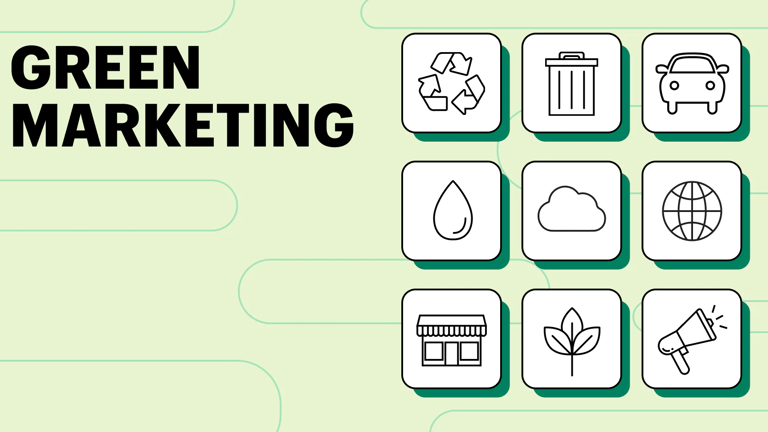Green Marketing Tech: Eco-Friendly Tools for Sustainable Digital Campaigns
Discover how green marketing is reshaping modern branding. This blog explores eco-friendly marketing strategies, sustainable technologies, low-energy tools, and practical steps for building environmentally responsible campaigns that resonate with conscious consumers.
6/28/20255 min read


One of the primary reasons for the elevation of green marketing is the rising demand for eco-friendly products. Today's consumers are more informed, self-aware, and conscious of their environmental impact. As a result, they actively seek out brands that commit to sustainable practices and produce eco-friendly options. By integrating green marketing into their strategies, companies can establish a meaningful connection with their target audience, ultimately fostering brand loyalty and trust.
Moreover, the concept of corporate social responsibility (CSR) plays a vital role in the realm of eco-friendly marketing. Brands that prioritize sustainability in their operations are often viewed as responsible corporate citizens. This perception enhances their public image, as consumers are more likely to support organizations that demonstrate social and environmental accountability. By leveraging their commitment to CSR, companies can effectively distinguish themselves in a competitive market and appeal to a growing demographic seeking ethical consumption.
In conclusion, understanding green marketing is essential for brands that aim to thrive in a rapidly evolving marketplace. By focusing on sustainable practices and eco-friendly marketing, organizations not only enhance their market presence but also contribute positively to the planet, aligning their operations with the values of increasingly conscientious consumers.
The Role of Technology in Sustainable Marketing
In recent years, the convergence of technology and marketing has underscored a new paradigm prioritizing sustainability. Sustainable technology plays a pivotal role in shaping marketing strategies that align with environmental goals. As consumers increasingly demand eco-friendly practices, businesses are leveraging various digital marketing tools to create campaigns that reflect their commitment to sustainability.
One significant area within this landscape is the utilization of low-energy hosting services. These platforms not only reduce the carbon footprint associated with website traffic but also demonstrate a brand’s dedication to sustainable practices. By opting for eco-friendly hosting solutions, marketers can enhance their online presence while simultaneously supporting the environment, thus marrying operational needs with ecological responsibility.
Additionally, carbon tracking software has emerged as a valuable asset for businesses committed to measuring and mitigating their environmental impact. This technology enables marketers to accurately assess the carbon emissions generated by their digital campaigns, allowing them to make informed decisions on how to reduce these emissions. Implementing such measures not only aligns marketing efforts with sustainability goals but also resonates well with environmentally conscious consumers.
Furthermore, sustainable social media platforms are fostering an eco-friendly digital marketing landscape by offering users a space to engage with brands that prioritize green practices. These platforms facilitate a community of like-minded individuals and brands, which enhances the visibility of eco-friendly campaigns, thereby driving collective action towards sustainability.
The role of data analytics in marketing cannot be overstated, particularly when it comes to assessing the effectiveness of green initiatives. Through data analytics, marketers can track engagement rates, conversion metrics, and overall campaign performance. This information is critical in optimizing future campaigns and ensuring that sustainability efforts yield tangible results. Investing in technology that promotes sustainable practices not only serves the environment but also strengthens brand reputation and customer loyalty.
Low-Energy Tools and Platforms for Marketers
In the realm of digital marketing, the adoption of low-energy marketing tools has become essential for organizations aiming to reduce their carbon footprint while maintaining effective campaigns. These eco-friendly solutions not only contribute to sustainability but also align with the growing consumer demand for environmentally responsible practices. Below is a curated list of recommended technologies that help marketers engage effectively, with a focus on their benefits and usability.
First on the list is energy-efficient email marketing software. Platforms such as Mailchimp and Sendinblue are notable examples that prioritize energy conservation. These services optimize their data centers for energy usage, resulting in reduced emissions throughout email campaigns. By utilizing analytics and automation features, marketers can execute campaigns with increased efficiency, leading to lower energy consumption.
Next, green website hosts provide an essential service for businesses eager to maintain a sustainable online presence. Companies like GreenGeeks and DreamHost utilize renewable energy to power their servers, thereby significantly cutting down on carbon output associated with traditional hosting services. In addition to their commitment to environmentally friendly practices, these hosts offer tools that enhance website performance, fostering better user experiences without compromising sustainability.
Moreover, eco-conscious advertising platforms, such as AdGreen and ecobranding, allow marketers to create advertising campaigns that prioritize sustainability. These platforms focus on transparent reporting and carbon offsetting initiatives, enabling businesses to visualize their environmental impact while promoting their products effectively. By leveraging these green advertising platforms, marketers can craft promotional strategies that resonate with environmentally-conscious audiences.
In summary, utilizing low-energy marketing tools, eco-friendly email software, and sustainable website hosting not only lowers carbon footprints but also enhances the overall effectiveness of digital campaigns, making them a vital consideration for forward-thinking marketers.
Implementing Green Marketing Strategies in Your Campaigns
Incorporating green marketing strategies into digital campaigns requires a structured approach. Begin by establishing clear sustainability goals that align with your brand's values. These objectives should be specific, measurable, achievable, relevant, and time-bound (SMART). For example, you might set a target to reduce carbon emissions from digital advertising by a certain percentage within a year. Setting such goals not only enhances your eco-conscious messaging but also allows you to track progress effectively.
Once goals are in place, focus on communicating your eco-friendly practices to consumers. It's crucial to highlight efforts such as using renewable energy in your operations or sourcing materials from sustainable suppliers. This transparency helps build trust and credibility, as consumers increasingly look for brands that demonstrate genuine commitments to sustainability. Utilizing various digital platforms, including social media, emails, and your website, you can effectively disseminate this information. Engaging visuals, compelling narratives, and infographics can further reinforce your message.
Furthermore, optimizing campaigns for sustainability is vital. This may involve selecting advertising methods that minimize environmental impact, such as digital over print advertising. Implementing techniques like targeted marketing and personalization can drastically reduce waste and improve efficiency. Adopting transparent marketing practices throughout your campaigns also fosters consumer loyalty, as it demonstrates accountability. Sharing your journey towards sustainability, including both achievements and challenges faced, can resonate with your audience.
By seamlessly integrating these strategies into your digital marketing efforts, you will not only advocate for sustainability but also create a significant impact that appeals to socially-conscious consumers. This approach positions your brand as a leader in eco-friendly practices within your industry, ultimately contributing to a larger movement towards environmental responsibility.
FAQ's on Green Marketing
Q1. What is the goal of green marketing?
Green marketing aims to promote environmentally friendly products and sustainable practices to meet the growing demand for ethical consumption.
Q2. How can businesses reduce carbon emissions in marketing?
By using low-energy platforms, carbon tracking tools, and sustainable hosting services, businesses can minimize digital emissions.
Understanding Green Marketing
Green marketing refers to the promotion of products and services based on their environmental benefits. This practice has gained significant traction in today's consumer landscape, where sustainability has become a crucial determinant of purchasing decisions. As consumers increasingly prioritize eco-friendly alternatives, brands are compelled to adopt sustainable practices to maintain competitiveness. This shift in consumer behavior reflects a broader societal movement towards environmental conservation and responsibility.
Contact Graphixio Today – Your Reliable Partner for Digital Marketing Services in Dehradun. Reach out to us for a free consultation and discover how our expert digital marketing services in Dehradun can accelerate your business growth.
Reach Out To Us
📞+91-7060648052
📞+91-7906148971
© 2024. All rights reserved.
Quick Links
Find Us On Social Media


Get To Know More About Us
